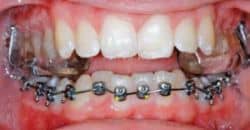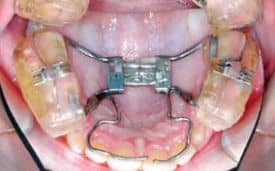by Michael C. Alpern, DDS, MS
Innovations in orthodontic and orthopedic expansion systems

Alpern
When asked what is the most beneficial treatment I can offer any patient, my answer is always the bonded Rapid Palatal Expansion Bite Plane (RPE-BP) System.

An anterior view of a maxillary bonded RPE-BP system shows the Class III protraction and Monacell hooks.
In growing patients who require maxillary and mandibular expansion, this procedure has the following long-term benefits, all of which can be accomplished in 5 to 6 months:
- orthopedic and orthodontic expansion (and potential protraction) of the maxilla;
- a significant increase in functional tongue room;
- an improvement in patients’ ability to breathe through their nose;
- more comfortable swallowing;
- a potential improvement of TMJ internal derangements;
- the creation of a broad, full smile; and
- the potential elimination of extraction of permanent teeth, long-term headgear, and orthognathic surgery.
Skeletal and dental width deficiency is a major factor in nearly all malocclusions. From Class I, II, and III patients to those with crowding and spacing problems, this type of expansion can play a major role in producing long-term, stable, and functional results.

An occlusal view of a bonded RPE-BP appliance shows that the inside acrylic is pink base plate wax, and vertical band material and a microscrew make removal safe. Also, note the lingual whip springs. This appliance has just been cemented, and no expansion has begun.
Recent Innovations
Haas was one of the first to introduce palatal expansion.1–5 It was not until Lagar indicated that existing occlusal cusp/fossa interdigitation stabilized malocclusions6 that I began to follow Haas and Subtelny’s advice of incorporating occlusal coverage to assist and enhance orthopedic and orthodontic expansion.7

An anterior view of a bonded RPE-BP system with crossbite hooks and mandibular bonded OrthoClassic T1 self-ligating brackets.
My expanders began with adding acrylic bite planes to banded expanders and evolved into all-bonded expanders with internal vertical band material and micro-expansion screws to assist in safe debonding.8
This initial development was followed by adding Class III protraction hooks, which connect to customized helmet protraction. Then we added crossbite and Monacell hooks to create “disposable anchorage” for mandibular alveolar dental uprighting. This significantly increased functional tongue room, often changing my initial diagnosis from “trial nonextraction” to “no extractions” in many patients.

A lateral view of a bonded RPE-BP system with active posterior bite planes (for restraining vertical growth) and Monacell crossbite hooks.
When we altered the acrylic bite planes of the bonded expander, we found that orthopedic and orthodontic vertical growth control was possible. This full-time vertical control nearly eliminated the need for headgear, not only restraining excessive vertical control, but also strongly encouraging more unencumbered mandibular orthopedic growth.

An occlusal view of a bonded RPE-BP appliance after 11 mm of expansion. The expansion screw has been ligated with .020 dead soft stainless steel wire and covered with light-cured Triad flowable acrylic for comfort.
After I had finished using the bonded RPE-BP System, this vertical control and functional appliance effect was transferred to bonded “composite functional covers” of varying thicknesses placed on mandibular molars and, periodically, mandibular bicuspids.
Recently, after evaluating initial and retention records of multiple patients, I realized that palatal expansion required lingual incisal control. Without lingual control of the incisors, palatal expansion can often lead to inferior and lingual movement of these teeth. In many patients, I did not want this movement, and more often wanted incisal protraction and/or intrusion. Thus, we added soldered .030 stainless steel lingual adjustable “whip” springs to the existing metal expansion appliance portion prior to acrylic construction.
The design of these lingual “whip” springs included adequate adjustment areas to individualize treatment goals. This permitted incisor protraction (and simultaneous intrusion), or just passive support to incisors, which prevented undesired lingual and inferior incisal movement during palatal expansion and stabilization.

An anterior view shows thick, active bite planes to restrain vertical growth, thus redirecting mandibular growth to a more forward direction. Expansion is complete, and crossbite elastics will begin to upright the mandibular lingually proclined molars and bicuspids. These elastics will connect from bonded lingual buttons on mandibular first molars to the Monacell hooks built into the buccal acrylic of the expansion appliance.
TMJ Benefits
Based on several hypotheses by Watson, Nuelle, and myself, we found that the bonded RPE-BP system, when used simultaneously with profound patient TMJ destructive habit-control training, helped many patients to experience significant improvements of pre-existing TMJ symptoms. Haas and others agree that orthopedic palatal expansion tends to move the origin of the lateral pterygoid muscles laterally toward their insertion. Others have conclusively found proof of this occurrence in CBCT studies.9
Nuelle and I have long published articles stating that TMJ internal derangements may be caused by excessive muscle tonus caused by midface deficiency. The RPE-BP system permits lateral movement of the lateral pterygoid muscle fibers toward their insertion. We combine this with full-time occlusal splint therapy, permitting orthopedic vertical unloading. We also provide destructive-habit-control training, such as eliminating jaw leaning and sleeping on the jaw. This combination often contributes to significant improvement in pre-existing TMJ symptoms.
Combining all of the previous patient advantages appears to substantiate the initial hypothesis that treatment with the bonded RPE-BP system is one of the most important procedures we can offer patients who require this treatment.
Michael C. Alpern, DDS, MS, a member of Orthodontic Products’ editorial advisory board, is in private practice in Port Charlotte, Fla. He can be reached at
REFERENCES
- Haas AJ. Rapid expansion of the maxillary dental arch and nasal cavity by opening the mid-palatal suture. Angle Orthod. 1961;31:73-90.
- Haas AJ. The treatment of maxillary deficiency by opening the mid-palatal suture. Angle Orthod. 1965;35:200-217.
- Haas AJ. Palatal Expansion: Just the beginning of dentofacial orthopedics. Am Orthod. 1970;57:219-255.
- Haas AJ. CJO/Interviews. J Clin Orthod. 1973;7:227-245.
- Haas AJ. Long-term posttreatment evaluation of rapid palatal expansion. Angle Orthod. 1980;50:189-217.
- Lagar H. The individual growth pattern and stage of maturation as a basis for treatment; distal occlusion with overjet. Trans Europ Orthod Soc 53rd Congress. July, 1967;137-145.
- Subtelny JD. Oral respiration: facial maldevelopment and corrective dentofacial orthopedics. Angle Orthod. 1980;50:147-164.
- Alpern MC. The Ortho Evolution: The Science and Principles behind Fixed/Functional Splint Orthodontics. Bohemia (NY): GAC International; 2003, 227-250.
- Personal communication with Haas AJ at the Angle Orthodontic meeting, 2008.










